Sauces are essential components of countless dishes, adding flavor, texture, and moisture. Learning how to thicken sauce without flour or cornstarch is especially beneficial for those following gluten-free, paleo, or low-carb diets. Knowing how to thicken sauce without flour or cornstarch ensures you can achieve the perfect consistency while meeting dietary preferences. Fortunately, there are many natural alternatives to explore that maintain both taste and texture. Here’s a guide on how to thicken sauce without flour or cornstarch using creative and natural methods.
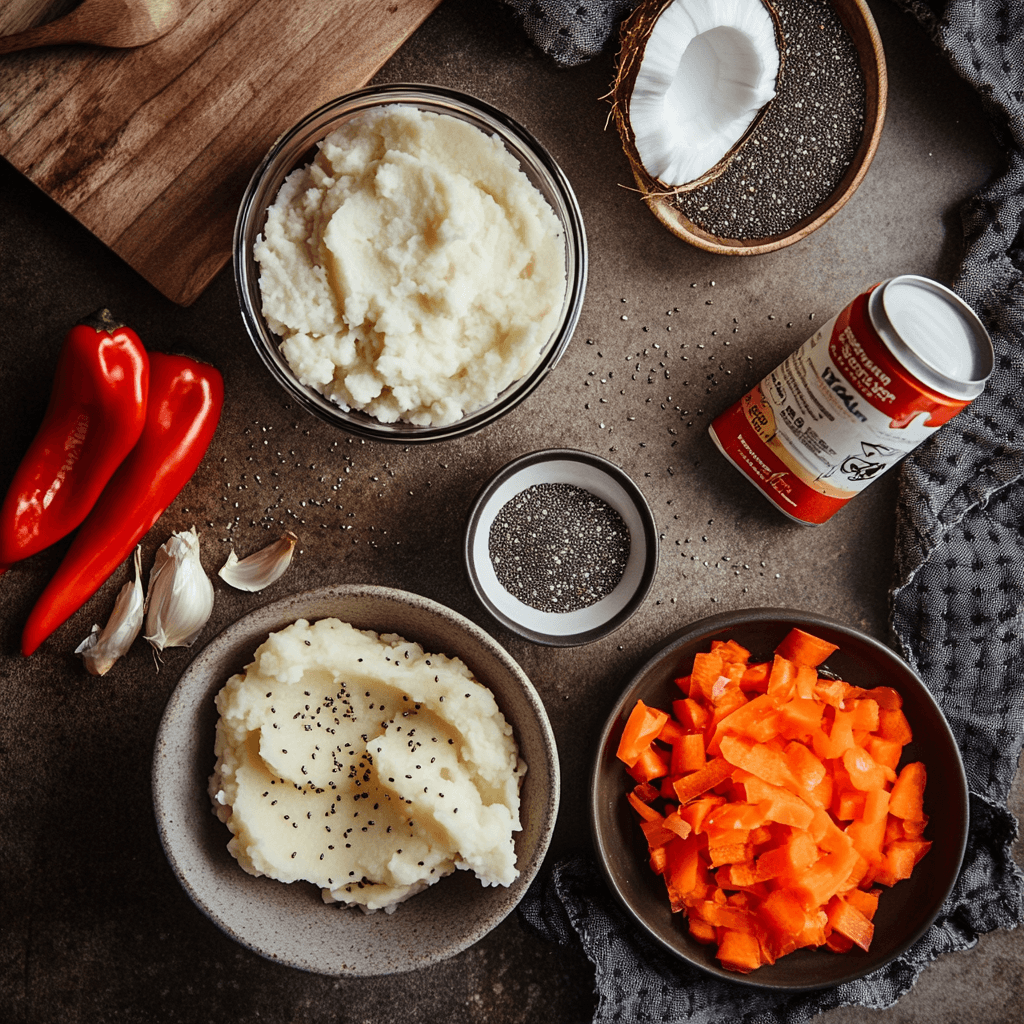
1. Reduce the Sauce
One of the simplest ways to learn how to thicken sauce without flour or cornstarch is by gently simmering it to allow the liquid to evaporate. This method not only intensifies flavors but also creates a richer, thicker consistency naturally, without requiring additional ingredients. If you’re curious about how to thicken sauce without flour or cornstarch, reducing the sauce through simmering is a proven technique. By cooking it over low heat, you can achieve the desired thickness while maintaining its natural taste.
How to do it:
- Pour the sauce into a wide, shallow pan to increase the surface area.
- Simmer over low to medium heat, stirring occasionally to prevent burning.
- Continue until the sauce reaches the desired thickness.
2. Use Puréed Vegetables
Puréed vegetables are a fantastic solution for anyone wondering how to thicken sauce without flour or cornstarch. They naturally add body and texture while enhancing the flavor and nutritional value of the dish. Ingredients like carrots, potatoes, sweet potatoes, or roasted bell peppers are excellent for achieving a thick and creamy consistency. If you need a gluten-free method, using puréed vegetables is one of the best ways to learn how to thicken sauce without flour or cornstarch effectively.
How to do it:
- Cook vegetables until soft, then blend them into a smooth purée.
- Stir the purée into your sauce and cook for a few minutes to incorporate.
- Adjust the seasoning as needed.
3. Add Mashed Potatoes
Mashed potatoes are an excellent option for anyone exploring how to thicken sauce without flour or cornstarch, particularly for creamy or savory sauces. They create a velvety texture and enhance the dish’s richness, making them a perfect gluten-free alternative. For those looking for natural methods, mashed potatoes are a reliable choice for learning how to thicken sauce without flour or cornstarch.
How to do it:
- Use freshly mashed or leftover mashed potatoes.
- Gradually whisk small amounts into your sauce until the desired thickness is achieved.
4. Incorporate Nut or Seed Butters
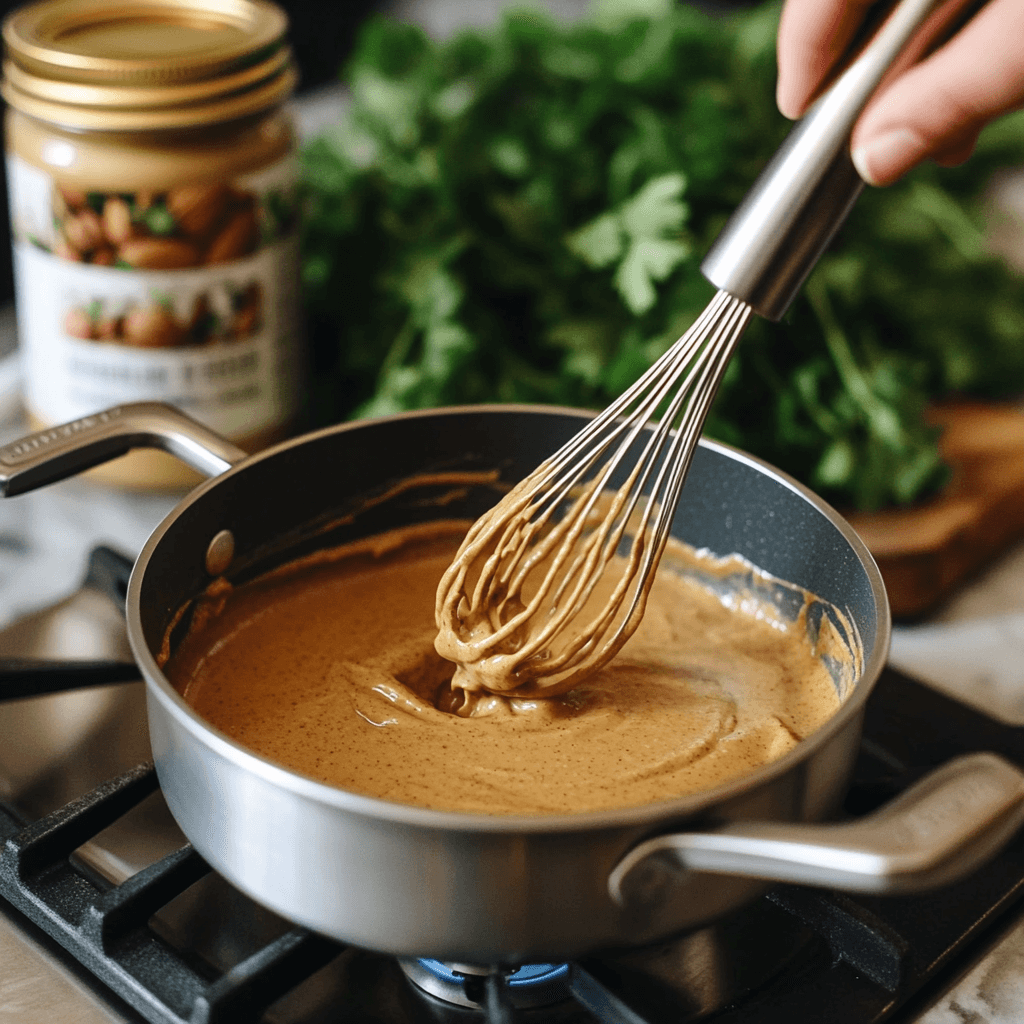
Nut and seed butters, such as almond, peanut, tahini, or sunflower seed butter, are great options for those wondering how to thicken sauce without flour or cornstarch. These butters add a rich, creamy texture while enhancing the sauce with a subtle hint of flavor. As a versatile and gluten-free alternative, nut and seed butters are an excellent choice when exploring natural methods for how to thicken sauce without flour or cornstarch.
How to do it:
- Stir in a small amount of nut or seed butter.
- Whisk thoroughly to ensure it blends smoothly.
- Add more as needed, keeping in mind the flavor profile of your sauce.
5. Use Cream or Coconut Milk
For cream-based sauces, heavy cream or coconut milk is an excellent option for those learning how to thicken sauce without flour or cornstarch. Simmering these ingredients naturally enhances the sauce’s richness while creating a smooth and velvety texture. This method is perfect for gluten-free recipes and is a reliable way to master how to thicken sauce without flour or cornstarch.
How to do it:
- Add cream or coconut milk to your sauce.
- Simmer gently, stirring occasionally, until it thickens.
6. Try Gelatin
Gelatin is a protein-based option for those exploring how to thicken sauce without flour or cornstarch. It works particularly well in savory sauces, providing a glossy finish that enhances the dish’s presentation. This natural thickener is an ideal choice for achieving the desired consistency in a variety of recipes.
How to do it:
- Dissolve gelatin in warm water or broth.
- Stir the gelatin mixture into your sauce and heat gently until thickened.
7. Incorporate Ground Nuts
Ground almonds, cashews, or hazelnuts are excellent options for those learning how to thicken sauce without flour or cornstarch, as they add both richness and texture to sauces.
How to do it:
- Grind nuts into a fine powder using a food processor.
- Stir the ground nuts directly into your sauce.
- Cook gently to blend the flavors and thicken the consistency.
8. Use Egg Yolks
Egg yolks are excellent for thickening creamy sauces, such as hollandaise or custards.
How to do it:
- Beat egg yolks in a separate bowl.
- Slowly whisk a small amount of the hot sauce into the yolks to temper them.
- Gradually stir the yolk mixture back into the sauce, cooking over low heat until thickened.
9. Add Chia Seeds
Chia seeds naturally swell and form a gel-like consistency, making them a great thickening agent.
How to do it:
- Grind chia seeds for a smoother texture, or use them whole for a more rustic finish.
- Stir them into your sauce and let it sit for 5–10 minutes to thicken.
10. Experiment with Xanthan Gum
Xanthan gum is a plant-based thickener commonly used in gluten-free cooking.
How to do it:
- Sprinkle a very small amount (1/8 to 1/4 teaspoon) into your sauce.
- Whisk vigorously to avoid clumping.
- Adjust gradually, as xanthan gum is highly potent.
Understanding Sauce Consistency
What Does “Thicker Sauce” Mean?
When we describe a sauce as “thick,” we’re referring to its viscosity or resistance to flow. Understanding how to thicken sauce without flour or cornstarch helps achieve a consistency that clings to food, delivering a richer mouthfeel and evenly distributing flavor with each bite. Thickness can be achieved by controlling the liquid-to-solids ratio, using natural thickening agents, or applying cooking techniques that enhance the sauce’s texture.
In practical terms:
- Thin sauces flow easily and are often used for light drizzling or as a base for other ingredients.
- Thicker sauces are more cohesive, holding their shape on a plate and enveloping food in a flavorful coating.
The desired thickness depends on the dish—whether it’s learning how to thicken sauce without flour or cornstarch for hearty, creamy sauces or achieving a light, runny consistency for vinaigrettes and salads.
The Role of Thickness in Culinary Dishes
The consistency of a sauce is essential in culinary art, influencing the texture, flavor, visual appeal, and overall experience. Understanding how to thicken sauce without flour or cornstarch ensures the perfect balance for any dish. Here’s why thickness matters:
1. Flavor Enhancement
A thicker sauce, often achieved by learning how to thicken sauce without flour or cornstarch, has a concentrated flavor due to reduced liquid content. This intensification ensures that every bite delivers the full spectrum of taste, making the dish more satisfying.
2. Texture and Mouthfeel
The texture of a sauce greatly influences the sensory experience. By mastering how to thicken sauce without flour or cornstarch, you can create a velvety, smooth sauce for a luxurious feel or a chunky, robust sauce for a rustic and hearty character.
3. Adhesion to Food
Thickness determines how well a sauce adheres to food. Learning how to thicken sauce without flour or cornstarch ensures a perfectly thick sauce that coats ingredients evenly, carrying flavor throughout the dish. This is especially important for dishes like pasta, grilled proteins, or vegetables.
4. Visual Appeal
The consistency of a sauce also impacts its presentation. Mastering how to thicken sauce without flour or cornstarch can help create a glossy, thick sauce that holds its shape, elevating the visual appeal of a dish and making it look more appetizing and polished.
5. Versatility in Cooking
Thicker sauces, often achieved by learning how to thicken sauce without flour or cornstarch, can be used creatively across various cuisines and techniques. They serve as dips, spreads, or fillings and can even act as a base for components like casseroles or layered dishes.
Striking the Right Balance
Achieving the perfect sauce consistency is both a science and an art. Factors like the type of dish, cooking method, and personal preferences all play a role. Learning how to thicken sauce without flour or cornstarch ensures you can adapt sauces to suit any culinary need. While some sauces are meant to be light and flowing, others shine when thick and creamy. Understanding the role of thickness helps chefs and home cooks make informed choices, creating dishes that are flavorful, texturally pleasing, and visually stunning.
Why Avoid Flour and Cornstarch?
While flour and cornstarch are traditional thickening agents in many recipes, they aren’t always the best choice for every cook or dish. Many people seek alternatives to learn how to thicken sauce without flour or cornstarch, whether due to dietary restrictions, health goals, or culinary preferences. Understanding the drawbacks of these staples and exploring healthier substitutes can open up exciting new possibilities in the kitchen.
Common Drawbacks of Using Flour or Cornstarch
1. Dietary Restrictions
- Gluten Sensitivity or Celiac Disease: Traditional flour contains gluten, which can be harmful to those with celiac disease or gluten intolerance.
- Carb Content: Both flour and cornstarch are high in carbohydrates, making them unsuitable for low-carb or ketogenic diets.
2. Nutritional Value
- Refined Ingredients: Both flour and cornstarch are highly refined, offering little in terms of fiber, vitamins, or minerals.
- Empty Calories: Their calorie content can add up without contributing significant nutrients to a dish.
3. Texture and Flavor
- Unwanted Flavor: Flour can impart a slight raw, grainy taste if not cooked properly. Cornstarch, when used in excess, may give sauces a chalky or overly glossy appearance.
- Over-Thickening: Both agents can quickly over-thicken a dish if not carefully measured, leading to a gummy or heavy consistency.
4. Limited Culinary Application
- Temperature Sensitivity: Cornstarch can break down when exposed to prolonged heat or acidic ingredients, making it less stable in some recipes.
Healthier Alternatives to Flour and Cornstarch
1. Vegetable Purées
- Nutritional Boost: Adding blended vegetables like carrots, squash, or cauliflower thickens sauces while contributing vitamins, fiber, and natural sweetness.
- How to Use: Cook and purée vegetables, then stir them into the sauce.
2. Nut and Seed Butters
- Rich and Creamy: Almond butter, tahini, or peanut butter can thicken sauces while providing healthy fats and protein.
- How to Use: Gradually whisk in small amounts and adjust the flavor accordingly.
3. Chia Seeds
- Nutritional Powerhouse: Rich in omega-3 fatty acids and fiber, chia seeds swell in liquid, creating a gel-like consistency.
- How to Use: Grind the seeds for a smoother finish or use them whole for a rustic look.
4. Gelatin or Agar-Agar
- Protein-Rich Option: Gelatin is an animal-derived thickener, while agar-agar is a plant-based alternative ideal for vegetarian or vegan diets.
- How to Use: Dissolve in warm water or broth and stir into the sauce.
5. Xanthan Gum
- Low-Carb Thickener: A small amount of this plant-derived powder can thicken sauces quickly without adding carbs or calories.
- How to Use: Sprinkle lightly and whisk to avoid clumping.
6. Arrowroot Powder
- Gentle on the Stomach: A gluten-free starch alternative, arrowroot thickens sauces without altering the flavor or texture.
- How to Use: Mix with cold water to form a slurry before adding to hot liquids.
7. Coconut Cream or Heavy Cream
- Rich and Decadent: For cream-based sauces, these options add thickness and depth without the need for flour or cornstarch.
- How to Use: Simmer to reduce and achieve the desired consistency.
8. Ground Nuts
- Texture and Flavor: Ground almonds, cashews, or hazelnuts provide a natural thickening effect along with nutty flavors.
- How to Use: Blend into a paste or powder and mix into the sauce.
Embracing New Culinary Approaches
Avoiding flour and cornstarch doesn’t mean sacrificing the quality of your sauces. By exploring how to thicken sauce without flour or cornstarch, you can create flavorful, nutrient-dense dishes that align with various dietary needs and preferences. Whether you’re cooking for health, taste, or creativity, these substitutes provide versatile and satisfying solutions.
Natural Ingredients to Thicken Sauce
Vegetables: The Power of Purées
Vegetables are a versatile and nutritious option for anyone learning how to thicken sauce without flour or cornstarch. They enhance the texture of a dish while adding depth of flavor and a boost of nutrients. Pureed vegetables create a creamy, smooth consistency without relying on traditional thickeners. With a variety of vegetables to choose from, the possibilities for thickening sauces naturally are endless.
How to Use Potatoes, Carrots, and Squash for Thicker Sauces
1. Potatoes
- Why Use Them: Potatoes are starchy and naturally creamy when cooked and mashed, making them an excellent thickener for savory sauces.
- How to Use: Boil or steam potatoes until soft, then mash or blend them. Stir the puree into your sauce and simmer to incorporate.
- Best For: Creamy soups, stews, and gravies.
2. Carrots
- Why Use Them: Carrots are slightly sweet and add a vibrant color to sauces. They also contribute fiber and natural sweetness.
- How to Use: Cook carrots until tender, then blend into a smooth puree. Add to sauces for both thickness and a hint of sweetness.
- Best For: Tomato-based sauces, curries, and marinades.
3. Squash
- Why Use It: Squash varieties like butternut and acorn squash are rich, naturally creamy, and have a mildly sweet flavor.
- How to Use: Roast or steam squash, scoop out the flesh, and blend until smooth. Stir the puree into sauces to thicken and enrich.
- Best For: Pasta sauces, risottos, and creamy casseroles.
How to Make a Vegetable Purée for Sauce
Creating a vegetable puree is simple and requires just a few steps:
Ingredients:
- Your choice of vegetable (e.g., potatoes, carrots, squash)
- Water, broth, or milk (for blending)
Steps:
- Cook the Vegetables: Boil, steam, or roast the vegetables until they are soft enough to mash or blend easily.
- Blend or Mash: Use a blender, food processor, or handheld masher to puree the vegetables until smooth. Add a small amount of liquid (water, broth, or milk) to reach the desired consistency.
- Incorporate into Sauce: Gradually stir the puree into your sauce over low heat. Adjust the amount based on how thick you want the sauce to be.
- Season: Taste and adjust the seasoning as necessary to balance the flavors.
Examples of Dishes Benefiting from Vegetable Purées
Vegetable purées can enhance a wide range of dishes, both in texture and flavor. Here are some examples:
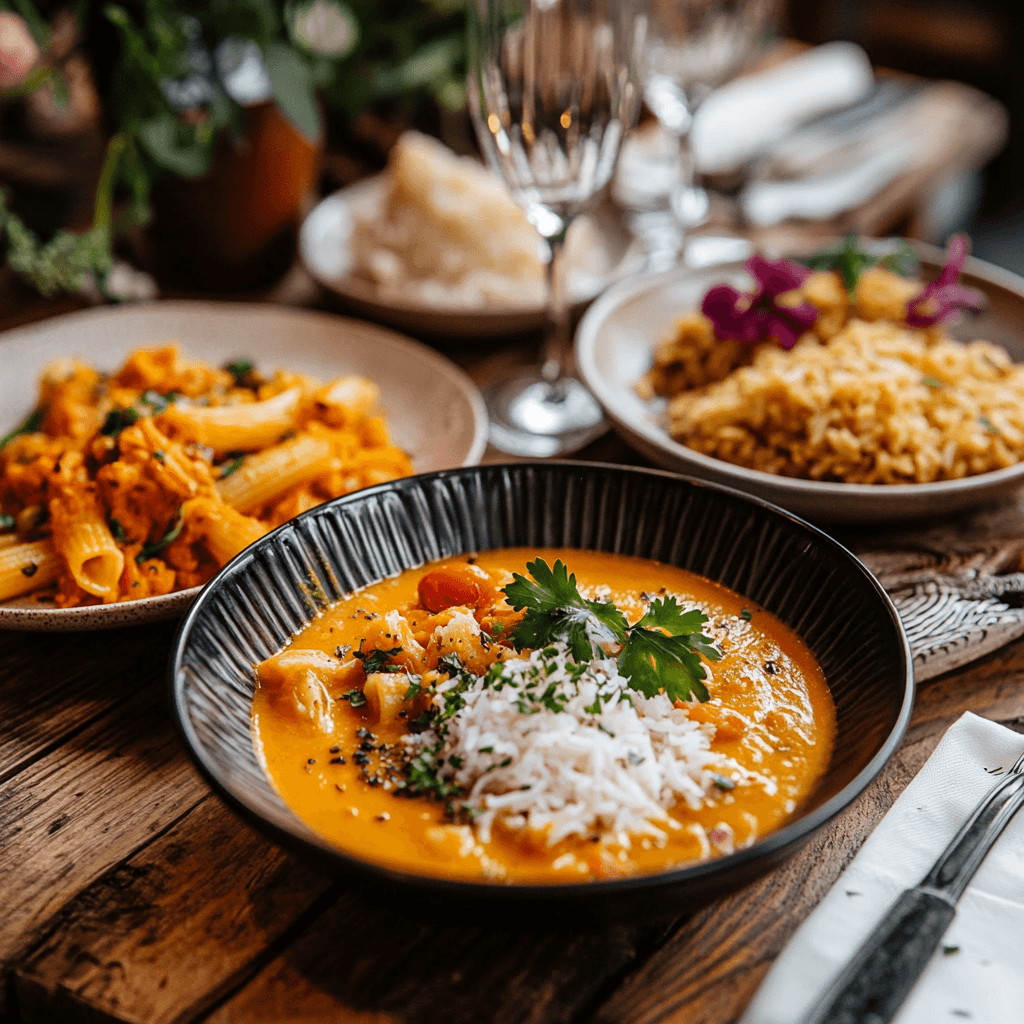
1. Creamy Tomato Sauce
- Add pureed carrots to balance the acidity of tomatoes and create a richer texture.
2. Butternut Squash Pasta Sauce
- Pureed butternut squash forms the base of a velvety sauce, perfect for fettuccine or penne.
3. Savory Beef Stew
- Thicken the broth with mashed potatoes for a hearty, rustic texture.
4. Carrot Curry Sauce
- Blend cooked carrots with coconut milk and spices to create a creamy, mildly sweet curry base.
5. Vegetable Soup
- Use a combination of blended root vegetables like potatoes and carrots to give body to the soup while keeping it dairy-free.
6. Shepherd’s Pie
- Replace the flour-thickened gravy with a smooth potato or squash puree for a healthier, flavorful filling.
How to Prevent Over-Thickening
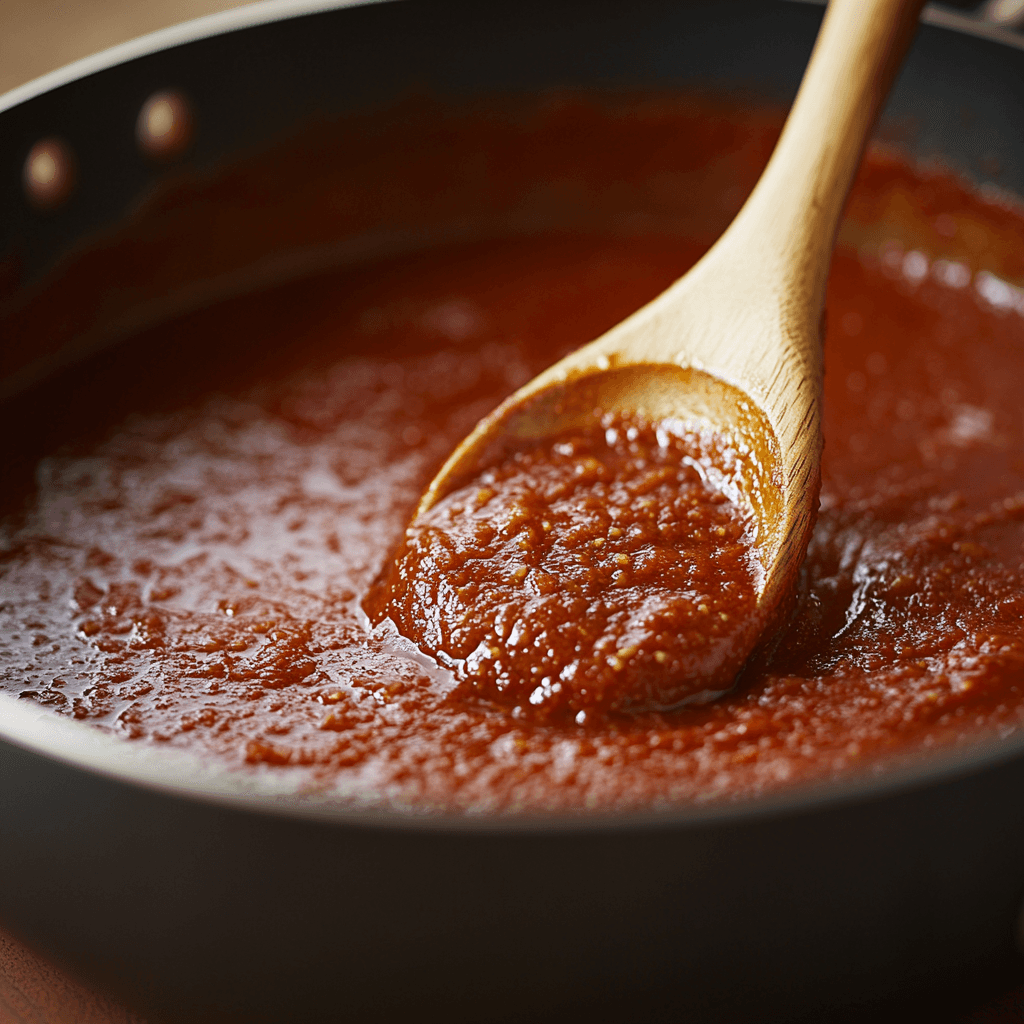
Achieving the perfect sauce consistency is an art. Learning how to thicken sauce without flour or cornstarch can enhance both texture and flavor, but over-thickening may lead to a heavy, unappetizing dish. Here’s how to identify the right consistency, avoid common pitfalls, and troubleshoot when things go wrong.
Identifying the Right Consistency
1. Know Your Sauce Type
Different sauces have varying ideal consistencies:
- Gravies and Cream Sauces: Smooth and pourable, but thick enough to coat the back of a spoon.
- Tomato-Based Sauces: Slightly chunky and thick enough to cling to pasta or proteins.
- Glazes: Dense but glossy, perfect for coating meats or vegetables.
2. The Spoon Test
Dip a spoon into your sauce and lift it out. If the sauce coats the back of the spoon evenly without dripping too quickly, it’s the right thickness.
3. Consider the Dish
The intended use of the sauce influences its consistency:
- Sauces for pouring should be slightly thinner.
- Sauces for dipping or spreading should be thicker.
Troubleshooting: What to Do When Sauce Gets Too Thick
1. Add More Liquid
Gradually stir in small amounts of liquid to loosen the sauce:
- Broth: Enhances savory flavors.
- Milk or Cream: Restores creaminess in dairy-based sauces.
- Water: Works well for neutral-flavored sauces.
2. Reheat Gently
Warm the sauce over low heat while stirring to ensure the added liquid incorporates smoothly.
3. Adjust Seasoning
Warm the sauce over low heat while stirring to ensure the added liquid incorporates smoothly, a key step when adjusting how to thicken sauce without flour or cornstarch effectively.
4. Use a Blender
For sauces that are both thick and lumpy, blend them to achieve a smoother texture.
5. Serve Strategically
If the sauce remains slightly thick, serve it over porous or absorbent foods like pasta or rice, which can help balance the texture.
Conclusion
Final Thoughts on Mastering Sauce Consistency
Perfecting sauce consistency requires attention to detail and an understanding of the ingredients and techniques at play. Whether you’re using natural thickeners, dairy, or reducing a sauce to intensify its flavors, knowing how to prevent over-thickening is essential for culinary success.
Remember:
- Take your time and adjust gradually.
- Test the consistency frequently during cooking.
- If mistakes happen, troubleshooting techniques like adding liquid or blending can rescue your sauce.
By mastering these principles, you can confidently create sauces that complement and elevate any dish, turning everyday meals into unforgettable culinary experiences.
Can you use taco seasoning in spaghetti?
Print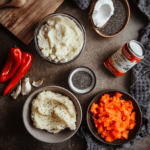
How to make sauce thicker without flour or cornstarch?
Description
If you want to learn how to thicken sauce without flour or cornstarch, here are several effective alternatives:
Reduce the Sauce
Simmer the sauce over low heat, allowing the liquid to evaporate. This naturally thickens the sauce while intensifying its flavor. Stir occasionally to prevent burning.Use Pureed Vegetables
Blend cooked vegetables (like carrots, potatoes, or cauliflower) and stir them into the sauce. They act as natural thickeners and add extra nutrients.
Example: Pureed tomatoes or roasted red peppers work well for tomato-based sauces.Add Mashed Legumes
Mash or puree beans (e.g., white beans or chickpeas) or lentils, then mix them into the sauce. This method is a great option when exploring how to thicken sauce without flour or cornstarch in savory dishes.Incorporate Nut Butter
Stir in a small amount of peanut butter, almond butter, or tahini for a creamy, thick texture. This method is excellent for savory sauces with a rich flavor profile.Egg Yolks
Whisk egg yolks into a small amount of warm sauce, then gradually mix the yolk mixture back into the main sauce. This technique is perfect for creamy sauces but requires gentle heating to avoid scrambling.Add Coconut Cream or Dairy
For creamy sauces, use heavy cream, sour cream, Greek yogurt, or coconut cream to thicken while adding richness. This is a simple and effective way to master how to thicken sauce without flour or cornstarch.Use Ground Nuts or Seeds
Finely ground almonds, cashews, or sunflower seeds can be stirred in to thicken sauces, especially in curries or gravies.Gelatin or Agar-Agar
Dissolve unflavored gelatin or agar-agar in warm water and mix it into the sauce. These thickeners work well for thicker, set sauces and are ideal for exploring how to thicken sauce without flour or cornstarch.Arrowroot Powder
If avoiding cornstarch specifically, arrowroot powder is a gluten-free, grain-free alternative. Dissolve it in cold liquid before adding it to the sauce for a smooth consistency.Psyllium Husk or Chia Seeds
Add a tiny amount of psyllium husk or ground chia seeds. These absorb liquid and create a gel-like consistency. Use sparingly to avoid a gummy texture while learning how to thicken sauce without flour or cornstarch effectively.
